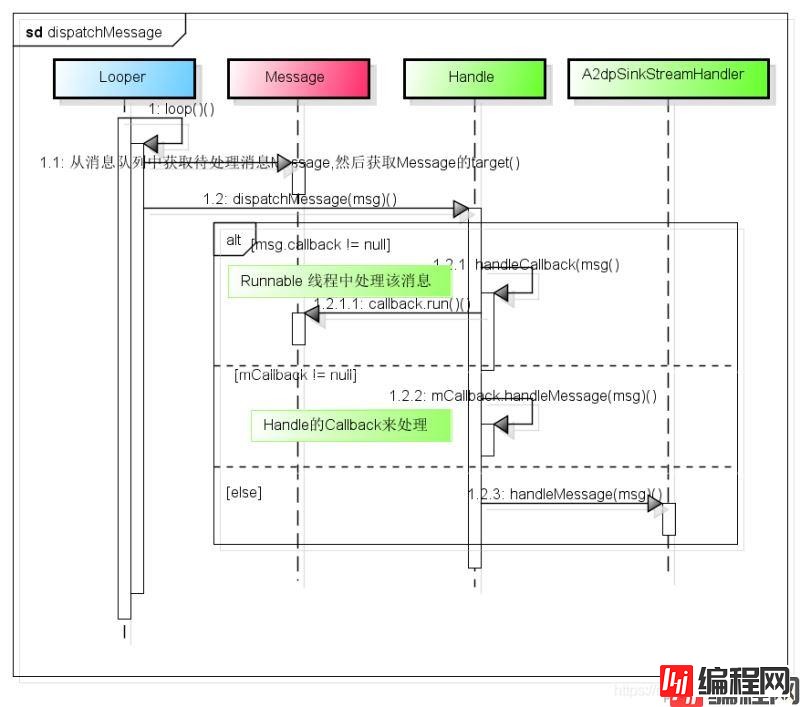1、Handle,MessageQueue,Message类图 Handle: 处理消息,并提供一系列函数帮忙我们创建消息和插入消息到消息队列中 创建handle实例--PbapCl
Handle: 处理消息,并提供一系列函数帮忙我们创建消息和插入消息到消息队列中
创建handle实例--PbapClientConnectionHandler
mHandlerThread = new HandlerThread("PBAP PCE handler", Process.THREAD_PRioRITY_BACKGROUND);
mHandlerThread.start();
//将这个线程设置为消息处理Looper线程
mConnectionHandler = new PbapClientConnectionHandler.Builder().setLooper(mHandlerThread.getLooper()).setContext(mService).setClientSM(PbapClientStateMachine.this).setRemoteDevice(mCurrentDevice).build();Looper作用:Looper的prepare函数将Looper和调用prepare的线程绑定在一起,调用线程调用loop函数处理来自该消息队列的消息。
Android 系统的消息队列和消息循环都是针对具体线程的,一个线程可以存在(当然也可以不存在)一个消息队列和一个消息循环(Looper),特定线程的消息只能分发给本线程,不能进行跨线程通讯。但是创建的工作线程默认是没有消息循环和消息队列的,如果想让该线程具有消息队列和消息循环,需要在线程中首先调用Looper.prepare()来创建消息队列,然后调用Looper.loop()进入消息循环
MessageQueue:消息队列,Handle和Looper中使用的是同一个消息队列



looper处理消息:
loop 使消息循环起作用,取消息,处理消息
public static void loop() {
final Looper me = myLooper();//返回保存在调用线程TLV中的Looper对象
if (me == null) {
throw new RuntimeException("No Looper; Looper.prepare() wasn't called on this thread.");
}
final MessageQueue queue = me.MQueue;//取得Looper对象的消息队列
// Make sure the identity of this thread is that of the local process,
// and keep track of what that identity token actually is.
Binder.clearCallingIdentity();
final long ident = Binder.clearCallingIdentity();
for (;;) {
Message msg = queue.next(); // might block 取消息队列中的一个待处理消息
if (msg == null) {
// No message indicates that the message queue is quitting.
return;
}
// This must be in a local variable, in case a UI event sets the logger
Printer logging = me.mLogging;
if (logging != null) {
logging.println(">>>>> Dispatching to " + msg.target + " " +
msg.callback + ": " + msg.what);
}
msg.target.dispatchMessage(msg);//调用该消息的Handle,交给它的dispatchMessage函数处理
}
}Handle -dispatchMessage
public void dispatchMessage(Message msg) {
if (msg.callback != null) {
//Message的callback不为空,则直接调用Message的callback来处理消息
handleCallback(msg);
} else {
if (mCallback != null) {
//Handle的全局Callback不为空
if (mCallback.handleMessage(msg)) {
return;
}
}
//调用handle子类的handleMessage来处理消息
handleMessage(msg);
}
}Message.callback用法:将Runnable当做一个Message
Runnable线程处理使用实例
mHandler.post(new Runnable() {
@Override
public void run() {
final IBinder b = callbacks.asBinder();
});
}到此这篇关于Android handle-message的发送与处理案例详解的文章就介绍到这了,更多相关Android handle-message内容请搜索编程网以前的文章或继续浏览下面的相关文章希望大家以后多多支持编程网!
--结束END--
本文标题: Android handle-message的发送与处理案例详解
本文链接: https://www.lsjlt.com/news/133831.html(转载时请注明来源链接)
有问题或投稿请发送至: 邮箱/279061341@qq.com QQ/279061341
下载Word文档到电脑,方便收藏和打印~
2024-01-21
2023-10-28
2023-10-28
2023-10-27
2023-10-27
2023-10-27
2023-10-27
回答
回答
回答
回答
回答
回答
回答
回答
回答
回答
0